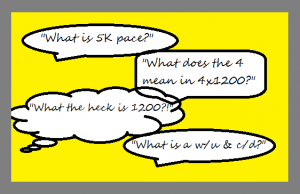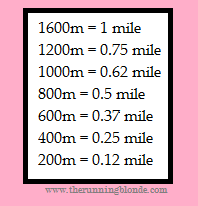Have you ever looked at a running training plan & thought you were back in high school algebra? If so, chances are you’re not alone! I recently Google’d something running related & read an article on the topic. When I scrolled down to the bottom & read some of the comments, I realized just how foreign “coaches/runners talk” can sound to the Average Joe. It can be intimidating to a newer runner to try & interpret what exactly they are supposed to do for a given workout. As runners gain experience, it is sometimes hard to recall the early days of running when they too had ignorance to common formulas & lingo. Have no fear folks; The Running Blonde will now answer some of those questions for you!

So, here is an example of a speed workout that I might assign an athlete: 1mi w/u + 5×1000 @ 5:20 (400 RI) + 1mi c/d. Did I just lose you?! No worries; let’s break it down piece by piece!
- 1mi w/u = a 1 mile warm-up {done at an easy, conversation pace}
- 5x1000m = doing 5 repeats of 1000m in 5 minutes, 20 seconds per interval with a break in between each one {1000m is equal to 0.62 miles}
- *Note: The time of 5:20 is given based on a recent 5K time of 28 minutes; this will vary from person-to-person*
- 400 RI = Recovery Interval is the time you take to catch your breath in between each repeat, achieved with a walk/slow jog depending on the workout for that day {400m is equal to 0.25 miles}
- 1mi c/d = a 1 mile cool-down {done at an easy, conversation pace}
The actual speed workout progression would look like this, for a total mileage of 6.1 miles:
- 1 mile easy to warm-up
- 0.62 miles {fast @ 5:20 total time for the interval}
- 0.25 miles {slow to recover}
- 0.62 miles {fast @ 5:20 total time for the interval}
- 0.25 miles {slow to recover}
- 0.62 miles {fast @ 5:20 total time for the interval}
- 0.25 miles {slow to recover}
- 0.62 miles {fast @ 5:20 total time for the interval}
- 0.25 miles {slow to recover}
- 0.62 miles {fast @ 5:20 total time for the interval}
- 1 mile easy to cool-down
On to the question of 5K pace… take your recent 5K time & divide it by 3.1 miles; this is your recent 5K pace. Or, you can use a handy smartphone app or website to do all the math genius work for you. Personally, I LOVE the Jack Daniels’ Running Calculator website: http://www.runsmartproject.com/calculator/. That’s definitely one every runner should have bookmarked!!
Here is a breakdown of common meter conversions to miles:

On to another type of workout & common question I get. “What exactly is a tempo run”? Well, the easiest elementary explanation to differentiate a tempo run from a speed work session is the length of time you are pushing yourself to the limits. And exactly how far into those limits have you pushed yourself! For speed work, you are enjoying quick bouts of fast running, for example for 3-5 minutes. Of course these can be longer if the 5K pace is slower. For a tempo run, the bout is much longer; like 5-15 minutes sometimes or even 3-6 miles. Speed work is usually in meters, whereas tempos are usually in miles. A 2-mile tempo run should never be as fast as your 400-meter pace. From slowest to fastest would be: easy -> tempo -> speed.
Here is an example of an assigned tempo run workout: 1mi easy + 2mi ST @ 9:18 + 1mi easy + 2mi ST @ 9:18 + 1mi easy.
- 1mi easy = a 1 mile run {done at an easy, conversation pace}
- 2mi ST = 2 miles of running, done at Short Tempo pace
- *Note: The time of 9:18/mile is given based on a recent 5K time of 28 minutes; this will vary from person-to-person*
The actual tempo workout progression would look like this, for a total mileage of 7 miles:
- 1 mile easy to warm-up
- 2 miles {@ 9:18/mile; for a total running time of 18:36}
- 1 mile easy to recover/catch your breath
- 2 miles {@ 9:18/mile; for a total running time of 18:36}
- 1 mile easy to cool-down
In the examples listed above, the “fake” athlete ran a recent 5K in 28:00; which is an average pace of 9:00/mile. Their short tempo (ST) pace would be slightly slower than their 5K pace. For a longer tempo run, say 3-5 miles, this would be run at mid tempo (MT) pace; naturally, slower than the short tempo pace. Lastly, a tempo run of 6-8 miles would be run at long tempo (LT) pace; you guessed it, even slower than mid tempo pace.
I hope this helps to explain the different types of workouts that you might see in a training plan. Feel free to email/PM The Running Blonde with any questions you might have regarding specific workouts; or hire her as your personal running coach to experience some of these workouts firsthand!
Leave a Reply